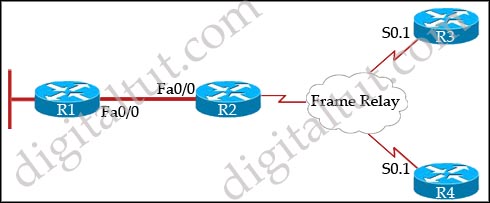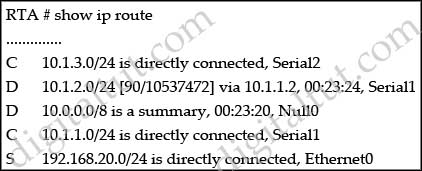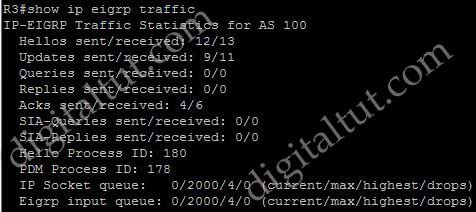EIGRP Questions 6
Here you will find answers to EIGRP questions – Part 6
Question 1
Which two statements are true about EIGRP manual summarization? (Choose two)
A. Manual summarization is configured on a per interface basis.
B. Manual summaries can be configured with the classful mask only.
C. When manual summarization is configured, autosummarization is automatically disabled by default.
D. The summary address is assigned an administrative distance of 10 by default.
E. The summary address is entered into the routing table and is shown to be sourced from the Null0 interface.
Answer: A E
Explanation
EIGRP allows you to summarize internal and external routes on virtually any bit boundary using manual summarization. And the manual summarization is configured under interface mode.
An example of manual summarization is shown below:
interface Serial0
ip address 10.1.50.1 255.255.255.0
ip summary-address eigrp 2000 192.1.0.0 255.255.252.0
(Reference: http://www.cisco.com/en/US/tech/tk365/technologies_white_paper09186a0080094cb7.shtml#manualsummarization)
Question 2
Which is the correct command format to configure EIGRP summary route?
A. ip auto-summary as-number address mask
B. ip summary-address as-number address mask
C. ip auto-summary eigrp as-number address mask
D. ip summary-route eigrp as-number address mask
E. ip summary-address eigrp as-number address mask
Answer: E
Explanation
Same as above question.
Question 3
Which is the most effective technique to contain EIGRP queries?
A. route summarization
B. configuring route filters
C. using a hierarchical addressing scheme
D. establishing separate autonomous systems
Answer: A
Question 4
Identify three characteristics of EIGRP feasible successors? (Choose three)
A. A feasible successor is selected by comparing the advertised distance of a non-successor route to the feasible distance of the best route.
B. If the advertised distance of the non-successor route is less than the feasible distance of best route, then that route is identified as a feasible successor.
C. If the successor becomes unavailable, then the feasible successor can be used immediately without recalculating for a lost route.
D. The feasible successor can be found in the routing table.
E. Traffic will be load balanced between feasible successors with the same advertised distance.
Answer: A B C
Question 5
Which two routing protocols require a metric to be configured when redistributing routes from other protocols? (Choose two)
A. RIP
B. OSPF
C. EIGRP
D. IS-IS
E. BGP
Answer: A C
Explanation
(RIP) metric is based on hop count, but Interior Gateway Routing Protocol (IGRP) and Enhanced Interior Gateway Routing Protocol (EIGRP) use a composite metric based on bandwidth, delay, reliability, load, and maximum transmission unit (MTU), where bandwidth and delay are the only parameters used by default. When we redistribute other routing protocols into RIP or IGRP/EIGRP, we must specify the seed metric for that route.
Note: When redistributing into OSPF, all routes are assigned a default metric of 20.
Question 6
Based on the need to limit processing and bandwidth utilization due to dynamic routing protocol operation, the following routing requirements have been specified for your network.
– partial and incremental routing updates
– only the devices affected by a topology change perform route recomputation
– route recomputation only occurs for routes that were affected
Which dynamic routing protocol should be deployed in your network to best meet these requirements?
A. BGP
B. OSPF
C. IS-IS
D. EIGRP
E. RIPv2
Answer: D
Explanation
For link-state protocols (like OSPF) when a change in topology is detected, a link-state advertisement (LSA) is sent to all routers in that OSPF area to inform the change. This causes all routers within that OSPF area to recalculate all of their routes using Dijkstra algorithm. For large networks, this is a CPU intensive task and could cause a CPU overload.
Also incremental routing update is also a unique feature of EIGRP.
Question 7
ACME Rocket Sleds is growing, and so is their network. They have determined that they can no longer continue using static routes and must implement a dynamic routing protocol. They want to have data use multiple paths to the destinations, even if the paths are not equal cost. Which routing protocol has the ability to do this?
A. EIGRP
B. OSPF
C. RIPv1
D. RIPv2
E. BGP
F. IS-IS
Answer: A
Explanation
An advantage of EIGRP is the use of unequal cost path to load balance traffic. This cannot be done in OSPF or RIP. BGP should only be used between ISPs. But notice that EIGRP is a Cisco proprietary protocol so it is not as popular as OSPF.
Question 8
Which command displays statistics on EIGRP hello, updates, queries, replies, and acknowledgments?
A. debug eigrp packets
B. show ip eigrp traffic
C. show ip eigrp topology
D. show ip eigrp neighbors
Answer: B
Explanation
The “show ip eigrp traffic” command displays the number of Enhanced Interior Gateway Routing Protocol (EIGRP) packets sent and received:
Question 9
Refer to the exhibit. EIGRP is enabled on all routers on the network. What additional configuration is required for the routers connected over the Frame Relay multipoint interfaces to compensate for a low-speed NBMA connection?

A. Configure the EIGRP hello interval on all Frame Relay interfaces to 5 seconds.
B. Configure the EIGRP hello interval on all Frame Relay interfaces to 60 seconds.
C. Configure the EIGRP hold time on all Frame Relay interfaces to 16 seconds.
D. Configure the EIGRP hold time on all Frame Relay interfaces to 180 seconds.
E. Configure the bandwidth on all EIGRP Frame Relay interfaces to the committed information rate (CIR).
F. Configure the bandwidth on all EIGRP Frame Relay interfaces to the lowest CIR multiplied by the number of PVCs for the multipoint connection.
Answer: F
Explanation
If the multipoint network has different speeds allocated to the VCs, take the lowest CIR and simply multiply it by the number of circuits. This is because in Frame-relay all neighbors share the bandwidth equally, regardless of the actual CIR of each individual PVC, so we have to get the lowest speed CIR rate and multiply it by the number of circuits. This result will be applied on the main interface (or multipoint connection interface).
Question 10
Refer to the exhibit. If the configuration shown below is added to RTA, which three route entries will EIGRP advertise to neighboring routers?(Choose three.)
| router eigrp 10 network 10.0.0.0 eigrp stub |

A. 10.1.3.0/24
B. 10.1.2.0/24
C. 10.0.0.0/8
D. 10.1.1.0/24
E. 192.168.20.0/24
Answer: A C D
Explanation
The “eigrp stub” command is equivalent to the “eigrp stub connected summary” command which only advertises directly connected and summarized routes to other routers.




h t t p : / / b i t . l y / 2 H o U N 3 A good site for you to study.